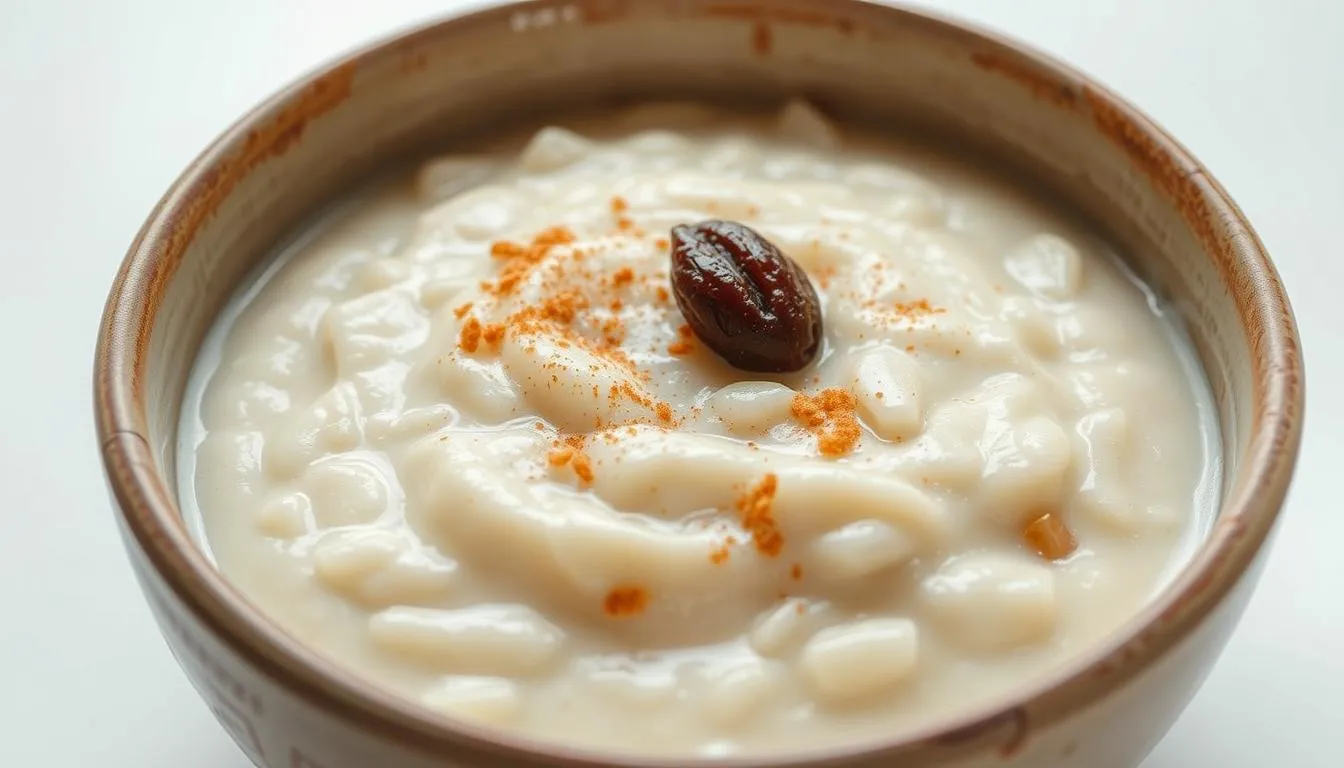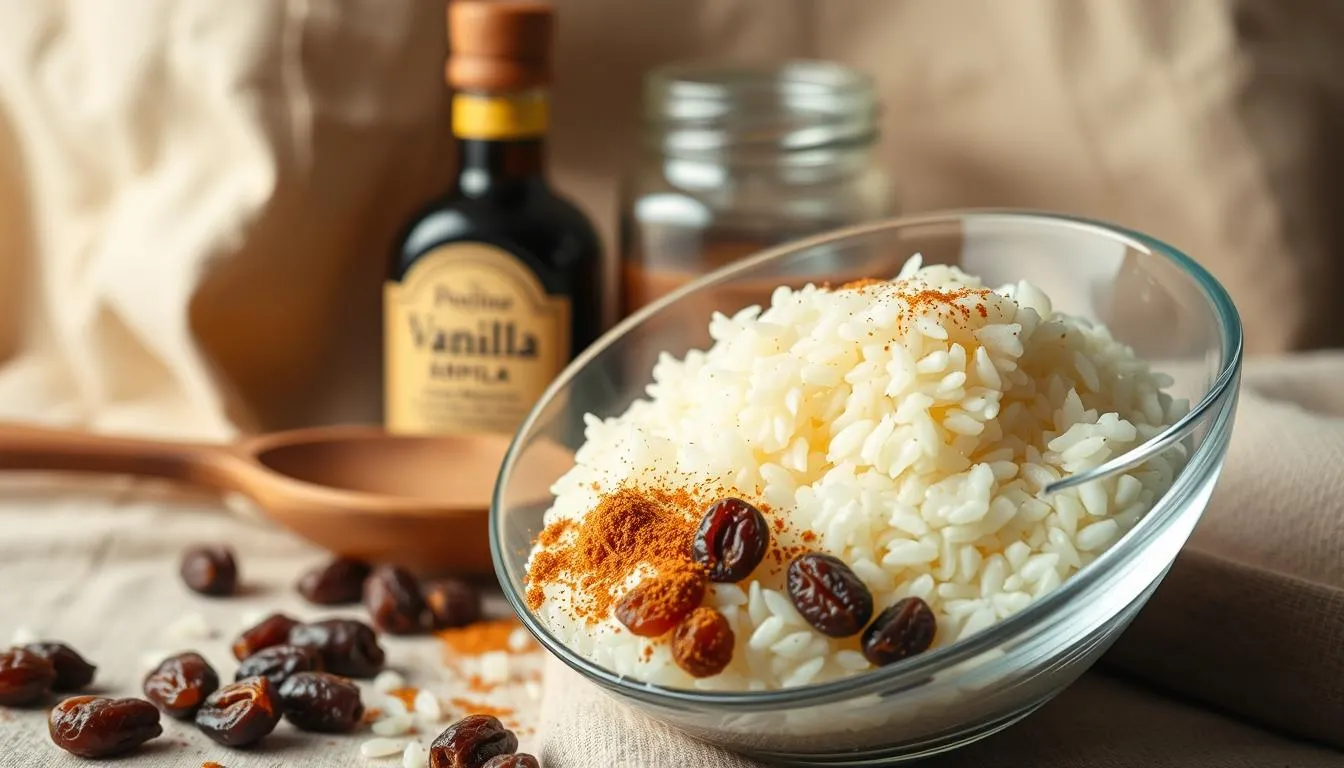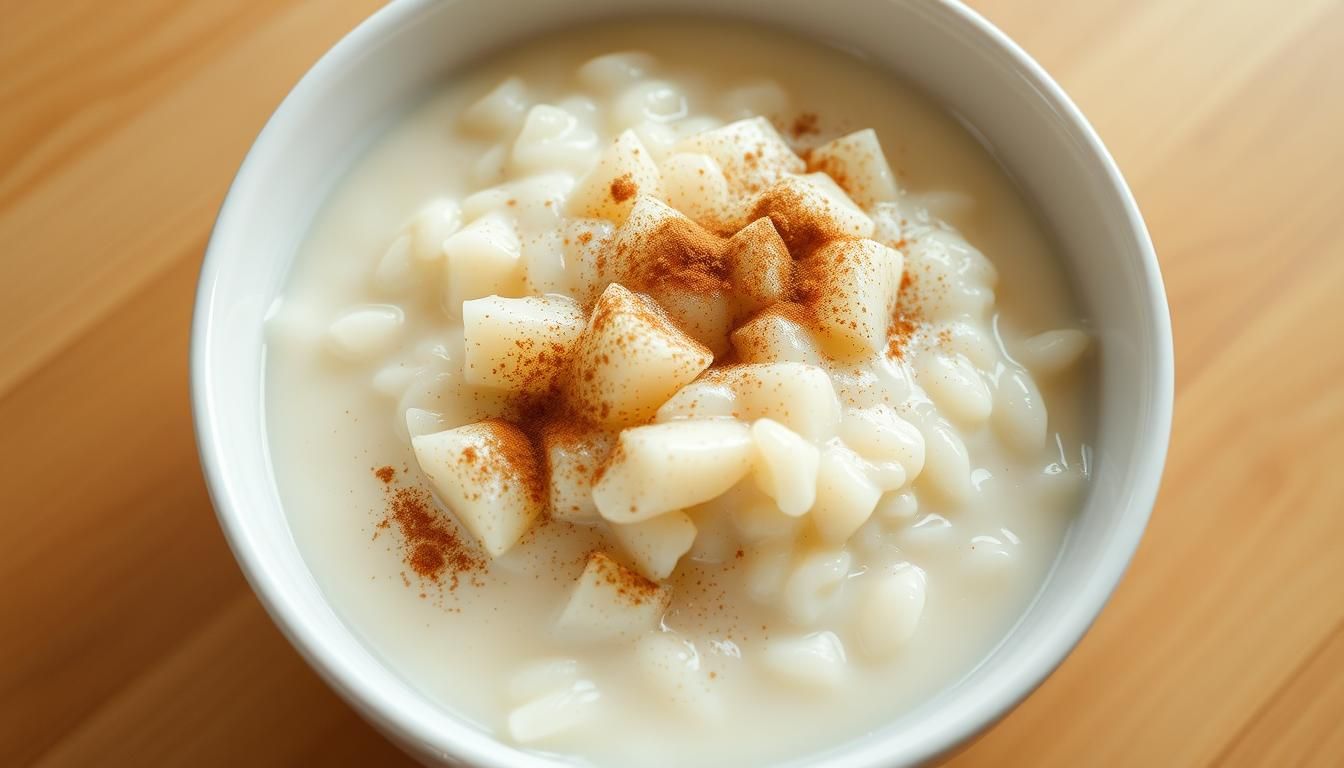There are foods that feel like home the moment they touch your spoon. This dessert brings that warmth in a bowl familiar, comforting, and quietly joyful. I still remember the first time a neighbor handed me a warm cup that smelled of milk and cinnamon; it felt like a hug after a long day.
This guide walks you through two trusted stovetop paths: a deli-style approach that uses a tempered egg for extra silkiness and a faster method that leans on arborio for creaminess. Both start with pantry staples milk, water, sugar, vanilla and rely on gentle heat, frequent stirring, and patient timing in minutes so the mixture sets just right.
I’ll also link a tested old-fashioned version for detailed proportions and nutrition so you can choose the exact style you want: old-fashioned rice pudding.
Key Takeaways
- Two stovetop methods let you pick speed or silkiness.
- Use gentle heat and frequent stirring to avoid scorching.
- Finish with vanilla, cinnamon, butter, and optional raisins for rich flavor.
- Expect 5075 minutes for deli-style or 1318 minutes for a quick arborio path.
- Store chilled in an airtight container up to 45 days; reheat with a splash of milk.
Why This Classic Dessert Works
This dish succeeds because simple kitchen chemistrystarch, dairy, and gentle heatdoes the work.
Arborio or mediumgrain grains shed starch slowly. That slow release builds a creamy body without turning the mix gluey. The result is a smooth texture that still shows individual kernels.
Using a mix of whole milk and some water helps the grains cook through while the milk adds body. A tempered egg in deli-style versions adds custardy richness and shine when you finish off the pot.
Keep the pan on mediumlow and stir often. Steady heat and frequent stirring prevent scorching and help the mixture thicken evenly. Expect total time around 4575 minutes depending on stove and grain.
Remember: the hot dessert will be thinner than the final chilled version. Vanilla and cinnamon add warm aroma without hiding the dairy and grain flavors.

| Factor | Effect | Tip |
|---|---|---|
| Grain type | Controls starch release and creaminess | Use arborio or mediumgrain for best texture |
| Milk vs. water | Milk adds body; water helps even cooking | Start with water, add whole milk as it simmers |
| Heat & stirring | Prevents scorch; builds silky mixture | Cook on mediumlow, stir often |
| Tempering egg | Adds richness and gloss | Whisk hot liquid into egg slowly, then return to pot |
Ingredients and Substitutions for Creamy Results
Start with a short shopping list and a few smart swaps to control texture and flavor.
Core ingredients
Whole milk is the easiest way to build a rich body; it blends with starch for classic creaminess without heavy cream. Use arborio rice or mediumgrain for the best starch release. Add granulated sugar, a scrape of vanilla extract or a bean, and a pinch of fine sea salt to balance flavor.

Smart swaps
If you’re short on time, use leftover cooked white rice and simmer it gently in milk and sugar for a fast version. Plump raisins in warm water before adding to keep them tender.
Try coconut milk or nut milk for a dairy-free twist, and add chopped nuts or shredded coconut at the end for texture.
Helpful tools
Keep a medium pot or a nonstick saucepan to prevent scorching. A whisk and a mixing bowl are handy for tempering an egg if you choose that silky finish. Measure in cups so the mixture thickens predictably.
“A pinch of salt and good vanilla lift the whole dish.”
| Item | Why it matters | Tip |
|---|---|---|
| Whole milk | Creates creamy body | Use full fat for best texture |
| Arborio or mediumgrain | Releases starch slowly | Shorter cook time than longgrain |
| Leftover cooked rice | Speeds the process | Simmer gently to absorb milk |
Rice pudding recipe: StepbyStep on the Stovetop
Work in two stages: hydrate the kernels in water, then build the creamy base with milk and sugar until the mixture thickens.
Method A (delistyle): Combine milk, water, rice, sugar, and salt in a large pot over just under medium. Bring to a gentle simmer with frequent stirring in about 1525 minutes. Reduce to low and cook 2535 minutes until the grains are tender and the liquid is reduced by roughly half.
Beat 1/2 cup milk with 1 egg in a bowl. Temper the egg by whisking in 1 cup of hot mixture slowly, then return the blend to the pot. Stir, add vanilla and raisins, and cook 3 minutes more.
Method B (faster): Add rice and water to a medium pot, bring to a boil, cover and simmer 15 minutes. Stir in milk, sugar, vanilla, and salt. Increase heat to reach a simmer and cook uncovered 1318 minutes, stirring often, until about 80% of desired thickness.
Watch visual cues: the warm pudding should be a bit looser than you want, since it firms as it cools. Remove heat, stir in butter for gloss, and finish with a sprinkle of cinnamon.

| Step | Timing (minutes) | Tip |
|---|---|---|
| Hydrate in water | 15 | Bring to a gentle boil, then simmer |
| Simmer with milk | 1335 | Stir often to prevent sticking |
| Temper egg | 23 | Use a cup measure to add hot liquid slowly |
Pro Tips, Timing, and Troubleshooting
Gentle attention at the stove will pay off more than rushing the process. Go low and slow: steady heat and frequent stirring help the mixture thicken evenly and keep each grain intact.
Plan for variable time. Some stovetops take roughly 5075 minutes using milk plus water; other methods finish nearer 45 minutes. Watch for tender kernels and a pot that looks slightly looser than the final texture you want.
Fixes for common issues:
- Too thin? Simmer uncovered a few more minutes or cool 1015 minuteschilling will firm it up.
- Too thick? Whisk in warm milk a tablespoon at a time until it relaxes.
- Scorched bottom? Remove heat, transfer the top portion to a clean pot (do not scrape), and add a splash of milk before gentle reheating.
Arborio yields extra creaminess; mediumgrain gives a slightly firmer bite. Adjust minutes by tasting a grain, not just the clock.
Serve warm for brighter aroma or chilled for denser creaminess. Reheat leftovers in the microwave in 30second bursts, stirring and adding a little milk. For best color and aroma, sprinkle cinnamon at the end.
“Slow, steady heat and regular stirring are the easiest ways to a silky finish.”
| Problem | Quick fix | When to use |
|---|---|---|
| Too thin | Simmer or chill | After cooking |
| Too thick | Stir in warm milk | After chilling |
| Scorched | Transfer top to clean pot | Immediate |
Flavor Variations and AddIns Youll Love
A few smart addins will lift the base and make each bite more interesting. Start simple and build from a classic finish: a light sprinkle of ground cinnamon and a bright Maraschino cherry give a delistyle flourish that never feels dated.
Warm spice options
Try: cinnamon, nutmeg, pumpkin pie spice, or a pinch of cardamom.
Add these near the end or as a garnish so their aroma stays vibrant.
Nutty and citrus twists
Fold in chopped pistachios or toasted pine nuts for crunch. A little orange zest lifts the sweetness and brightens the overall flavor.
Coconut vibes
Stir in shredded coconut and a few drops of coconut extract at the last minute for tropical aroma.
Classic mixins and serving ideas
- Keep it classic with cinnamon and plumped raisins plus a Maraschino cherry for nostalgia.
- If you love raisins, soak them briefly in warm water so they stay juicy.
- Offer toppingschopped nuts, citrus zest, ground cinnamon, or shaved chocolateso each bowl can be customized.
- A tiny splash of vanilla ties spices and nuts together without hiding the creamy center.
“Aim for balanceenough mixins to add interest while keeping the dairy and grain center stage.”
For more ideas and global variations, see the world’s best rice puddings collection.
MakeAhead, Storage, Freezing, and Reheating
Smart cooling steps help preserve that creamy mouthfeel you worked for. For makeahead service, portion hot pudding into a shallow dish to speed the cooldown. Let it sit at room temperature about one hour, uncovered, before moving to the refrigerator.
Refrigeration window and how to cool properly
Chill uncovered until fully cold to avoid condensation on the surface. Once cold, cover tightly. Store in the fridge for 35 days; texture will firm as the starch sets.
Freezer tips and safe thawing
Freeze in airtight containers with headspace for expansion. Label with the date and keep for up to 2 months. Thaw overnight in the refrigerator, then stir gently to recombine the creamy base.
Reheating and serving
Reheat on the stove over low, or warm in the microwave in 30second bursts, stirring and adding a splash of milk each time. When reheating on the stove, remove heat as soon as the mixture returns to a gentle simmer to avoid overcooking.
- Portion into singleserve cups for easy grabandgo meals.
- Prep a day ahead; loosen with warm milk and finish with fresh cinnamon before you serve rice pudding.
- For more makeahead pointers, see this make-ahead rice pudding guide.
“Cool uncovered, cover when cold, and reheat gently for best texture.”
Nutrition Notes and Serving Ideas
Before you pick toppings, lets overview what a typical serving contributes to your day.
Ataglance nutrition and portion guidance
A delistyle single serving is roughly 260 kcal with about 67 g fat, 7 g protein, and 44 g carbs. A lighter arboriobased bowl can be near 153 kcal with around 3 g fat and 28 g carbs.
These numbers change with milk, butter, eggs, and mixins. Use smaller cups or ramekins to control portions. For lower fat, choose skim or a lighter milk and skip the butter finish.
How to serve rice pudding: toppings, textures, and times of day
Top with nuts for healthy fat and crunch, or add fruit for vitamins and natural sweetness. A light dusting of ground cinnamon and a splash of vanilla extract lift aroma without extra sugar.
Serve warm in the evening for a softer, cozy treat. Chill for a denser, afternoon snack. If you love chocolate, finish with shaved chocolate or a pinch of cocoa for a decadent twist.
“Portioning into cups makes it easy to enjoy this dessert without overindulging.”
| Portion | Typical kcal | Why it matters |
|---|---|---|
| Delistyle | ~260 | Richer mouthfeel from whole dairy and egg |
| Arboriobased | ~153 | Lean, lower fat option |
| Addins | Varies | Nuts add fat and protein; fruit adds vitamins |
Conclusion
Conclusion
Before you serve, a quick recap helps you nail the result.
Use arborio or mediumgrain rice with whole milk, water, sugar, vanilla, and a pinch of salt as your base. Temper an egg if you want a delistyle, silky finish.
Cook gently over mediumlow heat and stir often. Expect about 4575 minutes total, watching for a glossy, slightly looser mixture that firms as it cools.
Finish with butter, plumped raisins, and a sprinkle of ground cinnamon when you serve. Cool properly, refrigerate for 35 days, or freeze up to 2 months.
Tip: Keep a cup of warm milk handy to loosen the bowl after chilling, and jot down any timing or sugar changes so your next batch is even better. Loved it or have a twist? Leave a comment to share your tweak.
FAQ
What type of grain gives the creamiest result?
Arborio or another mediumgrain variety delivers a naturally creamy texture because its starch releases during gentle simmering. Shortgrain works well too; longgrain tends to stay firmer and less silky.
Can I use leftover cooked rice instead of starting from dry?
Yes. Start with leftover cooked rice and reduce the simmering time. Add milk and sweetener, warm gently, and finish with vanilla and a pat of butter for richness.
How do I prevent scorching on the bottom of the pan?
Cook over medium to mediumlow heat and stir frequently with a heatproof spatula. A heavybottomed or nonstick saucepan helps distribute heat evenly and reduces burning risk.
When should I remove the dish from heat to get the right set?
Remove from heat while the mixture still looks slightly loose; it will thicken as it cools. If using an egg or custard step, temper the egg and fold it in off the heat to avoid curdling.
Can I make a dairyfree version that still feels rich?
Use fullfat coconut milk or unsweetened soy milk for creaminess. Add a splash of coconut extract or a spoonful of tahini to deepen mouthfeel if desired.
How long does it keep in the refrigerator?
Stored in an airtight container, it stays fresh for 3 to 4 days. Cool to room temperature first, then refrigerate promptly to maintain texture and safety.
Is freezing an option and how do I thaw it?
You can freeze portions for up to one month. Thaw overnight in the refrigerator and reheat gently on the stove or microwave with a little milk to restore creaminess.
What are quick fixes if the mix is too thin or too thick?
For thin results, simmer a bit longer to reduce liquid or stir in a beaten egg tempered with hot mix and cook briefly. For too thick, whisk in warm milk a tablespoon at a time until desired texture returns.
Should I add sugar at the start or near the end?
Add most sugar early so it dissolves and helps with texture, then taste and adjust near the end. A final splash of vanilla or cinnamon enhances perceived sweetness without extra sugar.
What spices and addins work best for flavor variations?
Ground cinnamon, cardamom, and nutmeg are classic choices. Fold in raisins, chopped pistachios, orange zest, or shredded coconut for contrast. A little dark chocolate or espresso powder adds depth.
How do I reheat single servings without drying them out?
Reheat gently over low heat with a tablespoon or two of milk, or microwave in 2030 second bursts, stirring between intervals to keep a smooth texture.
Can I use instant starches or thickeners instead of long cooking?
You can thicken with a slurry of cornstarch and cold milk for speed, but the finish wont match the natural creaminess that develops from cooking mediumgrain grains slowly.
Are addins like nuts and berries best added while hot or after chilling?
Tender fruits and some nuts can be stirred in while warm. Crisp toppings, toasted nuts, and fresh berries are best added just before serving to preserve texture.
What tools help make this dessert easier?
Use a medium pot with a heavy base, a whisk for smoothing, a wooden spoon for stirring, and a bowl for tempering eggs. A fine mesh sieve helps if you want an extrasilky finish.
